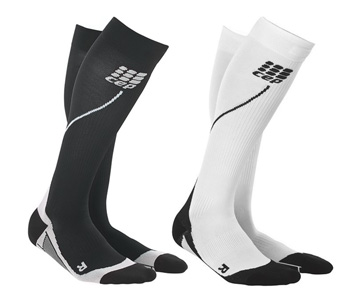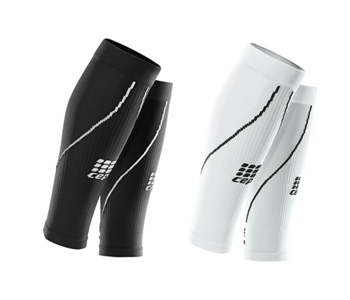You may have seen them, runners wearing tall socks and wondering if this is some sort of fashion statement. You may have even heard the term “compression” and wondered why all the buzz around this type of athletic apparel and whether it’s something you should consider wearing as well. Our Runner’s Compression Guide will help answer any questions you may have around compression gear.
Runner’s Compression Guide
Compression has been a technique that has been used in the medical community to help with blood circulation since the early 1900’s. Over the last 20 years, graduated compression and advances in manufacturing have brought the benefits of compression into the running community. These days there are plenty of brands that offer various compression garments including tights, socks, and calf sleeves. Manufacturers claim that compression helps to increase blood circulation, reduce blood lactate concentration while running, and control the amount of muscle movement that happens while running.
Do You Need Compression Gear
While not everyone needs compression gear, every runner can benefit from wearing compression for recovery. While there is no conclusive evidence that compression will help you while running, research has shown that compression does help reduce soreness and help you recover quicker. So if you’re feeling sore from long runs or you need to recover quicker, then wearing compression gear is for you. If you are experiencing shin pain, using compression during your run will help minimize some of the muscle movement and alleviate some of that shin pain. (Make sure the shoes are not the cause of the pain, read “Selecting The Right Running Shoe“).
Compression Socks or Calf Sleeves?
 This is always a popular question and for the most part, it’s a personal choice. However, here are some things to consider when deciding between each. If you choose compression socks to run, then these will become your running socks. So you’ll have to consider if you’ll need them for every run or maybe just for long runs. If you’re going to use them for every run, you may need to get more than one pair so you can switch them out and wash them. If you have a favorite brand or style of socks that you enjoy running in, then you should consider the calf sleeves.
This is always a popular question and for the most part, it’s a personal choice. However, here are some things to consider when deciding between each. If you choose compression socks to run, then these will become your running socks. So you’ll have to consider if you’ll need them for every run or maybe just for long runs. If you’re going to use them for every run, you may need to get more than one pair so you can switch them out and wash them. If you have a favorite brand or style of socks that you enjoy running in, then you should consider the calf sleeves.
 If you’re going to use compression for post-run recovery, here are some additional things to consider. Calf sleeves are not recommended for more than 2 hours if you’re going to be in a sedentary position. The graduated compression is designed to increase blood flow, but since the compression stops at the ankles, you may see some swelling at the base of the ankle. You’re also decreasing the amount of blood circulation at the foot that can lead to a blood clot. So for long periods of time in a seated or laying down position, we recommend going with a compression sock. A tip to improve your post-run recovery is to wear your compression socks and elevate your feet above your heart.
If you’re going to use compression for post-run recovery, here are some additional things to consider. Calf sleeves are not recommended for more than 2 hours if you’re going to be in a sedentary position. The graduated compression is designed to increase blood flow, but since the compression stops at the ankles, you may see some swelling at the base of the ankle. You’re also decreasing the amount of blood circulation at the foot that can lead to a blood clot. So for long periods of time in a seated or laying down position, we recommend going with a compression sock. A tip to improve your post-run recovery is to wear your compression socks and elevate your feet above your heart.
Sizing
The sizing in compression socks is not the same as your running socks. Don’t go by foot or shoe size. A quality compression product will require some measurement to get the proper fit for you. Because compression is designed to stimulate blood flow, if the sizing is too loose, it won’t provide you any benefit. Too tight, and you can limit blood flow. At the very least, your calf should be measured around the widest part and used for sizing. Some brands also require measuring around the ankle. Of course, all of our stores have a measuring tape on hand and can assist you with the proper sizing.
We hope your training is going well and that you refer back to the Runner’s Compression Guide so you know what will work best for you. As always, our experienced staff of Guest Advocates are available to answer any questions you may have. Good luck with your training and as we like to say, “may your best miles be those covered on foot!”


